#villa ludovisi
Text
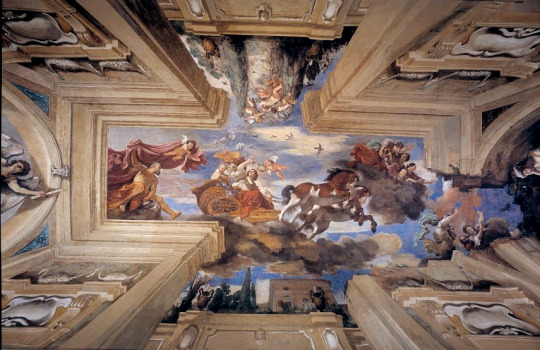
Il casino dell'Aurora Ludovisi, Guercino, 1621
#art history#art#italian art#painting#greek mythology#ancient greece#17th century#baroque art#guercino#aurora#tithonus#sunrise#cieling#aesthethic#rome#villa ludovisi#roman mythology
36 notes
·
View notes
Text

Ettore Roesler Franz - Villa Ludovisi verso il 1880
1 note
·
View note
Text

This intriguing 1st Century CE marble statue, discovered in Villa Ludovisi, Rome, depicts a child playing with a mask. The craftsmanship reveals a playful and humorous side of ancient Roman art, capturing a moment of innocence and joy.
1K notes
·
View notes
Text

1st Century CE marble statue, discovered in Villa Ludovisi, Rome, depicting a child playing with a mask.
72 notes
·
View notes
Text

Ceiling Painting Detail from Casino dell'Aurora, Villa Boncompagni Ludovisi, Rome (1621)
162 notes
·
View notes
Text

eucanthos
Socratic method diagram
Child playing inside ancient theater mask, 1st c. AD marble found in Villa Ludovisi, Rome
Gozié Ojini: Untitled 2023. Wood, cast iron, steel, felt, glue [piano parts]
studiounravel: Foam wraps
[aug 4 update]
8 notes
·
View notes
Text
0 notes
Text
Princess evicted from Rome villa with Caravaggio mural
Casino dell’Aurora is at the center of a bitter inheritance dispute.
An American-born princess was evicted on Thursday from an historic Rome villa, her home for the last 20 years, as a bitter inheritance battle with her stepsons took a dramatic turn.
Princess Rita Jenrette Boncompagni Ludovisi, 73, left the property in the presence of Carabinieri police, reports Italian newspaper Corriere della…

View On WordPress
0 notes
Text
A Texas-born princess who lives in a Rome villa containing the only known ceiling painted by Caravaggio is facing a court-ordered eviction Thursday, in the latest chapter in an inheritance dispute with the heirs of one of Rome's aristocratic families. Princess Rita Jenrette Boncompagni Ludovisi, a widow formerly known as Rita Carpenter, was still holding out at the Casino dell'Aurora on Wednesday night, awaiting what she expected to be the arrival of: her Ukrainian housekeeper Olga, the housekeeper's daughter, and two young grandchildren who fled Kyiv last year after Russia's invasion. In January, Rome Judge Miriam Iappelli instructed Carabinieri police at the Via Veneto station to evict her, accusing the princess of having failed, among other things, to maintain the home in a "good state of conservation" after an exterior wall crumbled. With the warning time now up, the decree calls for police to evict anyone still living there, take possession of the property, change the locks and "dispose of or destroy" any furniture or documents left behind. The house, located off the swanky Via Veneto, has been in the Ludovisi family since the early 1600s and became the subject of an inheritance dispute between the children from his first marriage and his third wife, the San Antonio-born Princess Rita, whom he married in 2009. The children have argued that the home, built in 1570, belongs to them, that their grandfather intended for them to inherit it, and that their late father abused them and mismanaged his multi-pronged legal campaign to get control of the property so it can be sold. One of the children, Bante Boncompagni Ludovisi, took to Twitter on Wednesday to praise Iappelli's eviction order and assert the children's right to the villa and its contents. The widow Boncompagni Ludovisi says she and her husband worked diligently to restore the villa as best they could, adding that she has tried to negotiate with her late husband's children Wednesday; she called her imminent eviction "unexpected and unjust." The eviction order marked the culmination of a bitter inheritance saga that simultaneously saw the villa put on the court-ordered auction block last year and assigned a court-appraised value of 471 million euros ($533 million) from 353 million euros ($400 million) progressively lowered in a series of successive auctions, with more scheduled until a buyer is found. The villa, also known as Villa Ludovisi, is famous for the Caravaggio that graces a tiny room off a spiral staircase on the second floor. The villa, also known as Villa Ludovisi, is famous for the Caravaggio that graces a tiny room off a spiral staircase on the second floor in 1597 by a diplomat and patron of the arts who asked the then-young painter to decorate the ceiling of the small room being used as an alchemy workshop. The 2.75-meter (9-foot) wide mural, which depicts Jupiter, Pluto, and Neptune, is unusual: It's not a fresco but rather oil on plaster, and it represents the only ceiling mural that Caravaggio is known to have painted. The American princess previously was married to former U.S. Rep. John Jenrette Jr. of South Carolina.
0 notes
Photo

A Hidden Caravaggio Masterpiece, An Inheritance Feud, and a Roman Villa up for Sale
This story was originally published on The Conversation and appears here under a Creative Commons license. I teach Italian Renaissance and Baroque art, so when I was visiting Rome in January, how could I not try to see a notorious villa that was up for sale and involved in a nasty inheritance dispute? The Villa Aurora, named for the masterful fresco by the 17th-century artist Guercino that adorns the ground-floor salon, also happens to house a rare ceiling painting by Caravaggio, the 17th-century “rebel artist,” whose name makes the art market salivate. I wanted to see the Caravaggio, and not just because its assessed value of US$331 million drove up the estimated price for the villa, apparently scaring off buyers. Perhaps because of the difficulty in reproducing the work or even viewing it, the Caravaggio has received remarkably little attention from art historians. The villa, which has gone through five failed auctions—the first one asking a cool $502 million—needs maintenance, and Italian law dictates that the Caravaggio and other art cannot be removed. It is not easy to see privately held art, and given the ongoing controversy, I figured my chances were especially slim. But I duly wrote to the email address I found online. A week later I got a response, and after some back and forth, on the day before I was to leave Rome, I was invited to come to the villa at 6 p.m. sharp. A woman named Olga met me at the door: “The principessa will be with you in a moment,” she said. The current inhabitant of the villa is an American-born princess named Rita Boncompagni Ludovisi. A former Texas GOP opposition researcher, she was once married to a congressman caught in the Abscam scandal and posed for Playboy twice in the 1980s. Her second husband, Nicolò Boncampagni Ludovisi, was Prince of Piombino. He owned the villa and promised her usufructuary rights, meaning she should be allowed to occupy the villa until her death. But the prince’s three sons from his first marriage are forcing the sale because, according to Italian law, inheritances must be divided between the surviving spouse and any descendants. It’s a media story to die for: old-world aristocrats face off against a supposed bimbo and gold digger from Texas—with a Caravaggio thrown in for good measure. The villa was historically known as the Casino Ludovisi, but it became famous among art historians for its ceiling painting by Guercino. In a tour de force of illusion, the ceiling is painted to look as through the architecture opens up to the sky with the goddess Aurora, or Dawn, driving her chariot across the space above. The Caravaggio, by contrast, barely registers in the voluminous scholarship on the artist. I looked down in dismay at my sneakers, my corduroy pants, and my purple Eddie Bauer jacket that has seen better days: I hadn’t anticipated meeting the principessa herself. Olga guided me into a second room and introduced me to the principessa. She is most definitely American – tall, blond and looking much younger than her age of 73. After talking extensively about the villa and its works of art, Rita, as she calls herself, introduced me to a dapper Italian man from the Ministry of Culture, whom, she explained, could hopefully stop her imminent eviction from her home. She then showed me the magnificent painting by Guercino. Then a journalist from the Italian newspaper La Stampa appeared, and the principessa was whisked away for an interview. She told me, in parting, “Olga will show you the Caravaggio.” Olga led me up a spiral stairway to the second floor: “Here is the other Guercino,” she said. I looked up to see a second illusionistic fresco, the same size as the one on the ground floor, this one depicting the figure of Fame flying through the sky. I hadn’t known this one even existed. Then Olga turned on the lights in what looked like a small hallway, its walls painted a bright, hospital white. I looked up to see Caravaggio’s painting, which depicts muscular nude men surrounding a translucent white globe. The detail is intense, the colors bright and sharp in a way that is exceptional for a ceiling painting. Caravaggio managed to make the three-headed dog Cerberus look as though it really existed, bringing to life the creature’s soft black and white fur, the red of its eyes, the pink ribbing of one upper mouth and the white glint of its teeth. I later learned that the picture had not been painted in the traditional fresco technique, on wet plaster, but with the unusual application of oil on dry plaster, allowing Caravaggio to execute the precision, color, detail, and texture. Although some art historians have questioned the attribution, there is no doubt in my mind that this is Caravaggio. Only he would—even could—paint such a seemingly plausible Cerberus. The composition works only in its original location, since the scale, height and curvature of the ceiling transform the work. The painting purports to show a rectangular opening in the ceiling through which viewers can see the sky and clouds. In the center, within a white globe depicting the universe, one sees the Sun, Moon and signs of the horoscope. On each side of the globe are the nude, burly he-men: on one side, Jupiter, awkwardly flying through the sky on an eagle, pushes the sphere; on the other, Jupiter’s brothers, Pluto and Neptune, stand as if at the edge of the opening in the ceiling, looking down. Perhaps Caravaggio did this for his friend and patron as a kind of joke. Given its lack of scholarly attention, the Caravaggio is much more compelling than I expected. One 17th-century biographer, Pietro Bellori, claimed that Caravaggio painted the work to silence critics who alleged that he lacked the technical skill to pull off the tricks in perspective required for ceiling art. But I think Caravaggio was up to something more complicated. His aim was not so much to prove he could paint with foreshortened figures and receding architecture, but rather to make fun of the fad for illusionistic ceiling paintings that render scenes “as if seen from below”—“di sotto in su,” as it is termed in art history. Running with the concept of “di sotto in su,” Caravaggio cheekily gives onlookers a graphic view from below of Pluto’s penis and testicles, not to mention a novel perspective on his buttocks. Caravaggio didn’t stop there. Jupiter’s pose is almost incomprehensible, his face concealed, his limbs flailing in different directions—very undignified, particularly for an oversize Olympian god. It’s an NFL linebacker riding an overmatched eagle. From between Jupiter’s legs emerges the very phallic long neck and beak of the eagle with his bright, dark eye glaring down at the mortals below. (In Italian, “bird” is slang for penis.) Pluto and Neptune also have their pets, which are themselves rivals: Pluto’s snarling dog frightens Neptune’s seahorse. Neptune, who is Caravaggio’s self-portrait, in turn looks threateningly at Pluto. And then there is the juxtaposition of Cerberus’ bared teeth and Pluto’s very exposed “equipment.” When I consider the patronage of the painting, it all makes sense. Caravaggio painted the ceiling in 1599 or 1600, when the villa was owned by his first important patron, Cardinal Francesco del Monte. Caravaggio lived in del Monte’s palace in town, and there is evidence to suggest that they both enjoyed the company of young men, and they may even have been lovers. While it is difficult to confirm the men’s sexual preferences, there is no question that the ceiling is a product of their shared sensibility: locker room art for sophisticated, 17th-century cultural “jocks.” The room was Del Monte’s “studiolo,” a type of small room usually used by members of the wealthy elite to get away from it all and “study” (whatever that might entail). The ceiling was to be shared by a bon vivant, learned cardinal with a select audience of like-minded men. Caravaggio never painted another ceiling because tricks of perspective were fundamentally incompatible with his realist inclinations, but perhaps he did this one for his friend and patron as a kind of joke. I left the Villa Aurora that night with a new perspective on 17th-century art and full of thoughts about the role these works of art, created for members of an extraordinarily privileged elite of the past, play in our modern democratic society. The same day as my visit, the judge in the inheritance dispute ruled that the principessa would be evicted from the villa to facilitate its sale. I suspect this is devastating for her, given how much effort she has put into preserving her husband’s legacy. But I also wonder what will happen to this villa and its unique collection of 16th- and 17th-century ceiling paintings. I think it would be a travesty for them to remain in private hands, because everyone, including my students, should be able to see these works. Art historians know about the tensions between private property and cultural heritage, but this is a real opportunity for the new Italian Minister of Culture, Gennaro Sangiuliano, to set an example, as his predecessors have done with the Palazzo Grimani at Santa Formosa in Venice. Once the residence of a wealthy and powerful noble family, Palazzo Grimani fell into disrepair until it was purchased in 1981 by the state. After many years of renovation, it opened as a public museum in 2008. The frescoes in the Palazzo Grimani are not nearly as artistically significant as those in the Villa Aurora, but the museum today is one of the most interesting monuments in Venice. I believe the Villa Aurora, restored and open to everyone as a museum of Renaissance and Baroque ceiling painting, could do the same for Rome. Monika Schmitter is a professor and chair of History of Art and Architecture at UMass Amherst.
https://www.atlasobscura.com/articles/caravaggio-art-hidden-villa-aurora
0 notes
Text
Un mannequin Playboy devenu aristocrate a défié la décision d'un juge italien exigeant qu'elle quitte la Villa Aurora du XVIe siècle qui abrite une fresque unique au plafond du Caravage.En plus d'une querelle de propriété amère avec les fils de son défunt mari, la princesse Rita Boncompagni Ludovisi a été accusée de négliger le bâtiment historique.Jeudi, une cinquième vente aux enchères s'est clôturée sans aucun acheteur potentiel.Un juge de Rome a statué que la propriété n'était pas correctement entretenue après l'effondrement d'un mur. Le tribunal a également conclu que la princesse Rita, née aux États-Unis, qui s'est mariée dans l'une des familles nobles les plus distinguées d'Italie, aurait organisé des visites non autorisées de la villa, ce qu'elle nie."J'entends défendre vigoureusement mon droit d'usage,», a déclaré la princesse Rita aux médias, commentant la décision du tribunal.La Villa Aurora, dont la valeur est estimée à 539 millions de dollars, possède la seule peinture murale du Caravage au monde, qui représente les dieux olympiens Jupiter, Neptune et Pluton.La princesse née aux États-Unis a été mêlée à un différend successoral de longue date avec les trois fils de son défunt mari, le prince Nicolo Boncompagni Ludovisi, après sa mort en 2018.Alors que le défunt aristocrate a donné à sa femme le droit de rester dans la villa pour le reste de sa vie dans son testament, ses fils, Francesco, Ignazio et Bante se sont opposés et ont porté l'affaire devant les tribunaux.
LIRE LA SUITE:
L'une des propriétés les plus chères à vendre dans la "vente aux enchères du siècle"
Les parties impliquées dans la querelle ont convenu de mettre la résidence aux enchères, mais jusqu'à présent, elle n'a attiré aucun enchérisseur.La villa étant sous la protection du ministère italien de la Culture, il est possible que l'État l'achète éventuellement. La princesse Rita, cependant, a exprimé des doutes quant à savoir si l'Italie "peut payer un prix aussi élevé.”
Vous pouvez partager cette histoire sur les réseaux sociaux :
Suivez RT sur
0 notes
Text

Claude Joseph Vernet - Vista del parco di Villa Ludovisi
2 notes
·
View notes
Text
Princess faces eviction from stunning Roman villa with Caravaggio mural | World News
Princess faces eviction from stunning Roman villa with Caravaggio mural | World News
A Texas-born Italian princess faces eviction from a Roman villa which has the world’s only known mural painted by the renaissance artist Caravaggio, as part of a bitter inheritance battle over the future of the unique property.
Princess Rita Jenrette Boncompagni Ludovisi, 73, whose extraordinary life has encompassed acting, modelling for Playboy, becoming a New York real estate broker, and…

View On WordPress
0 notes
Photo
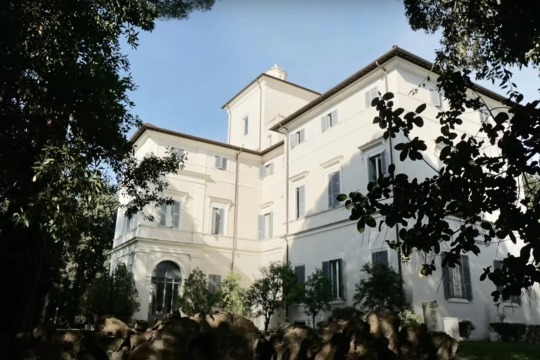
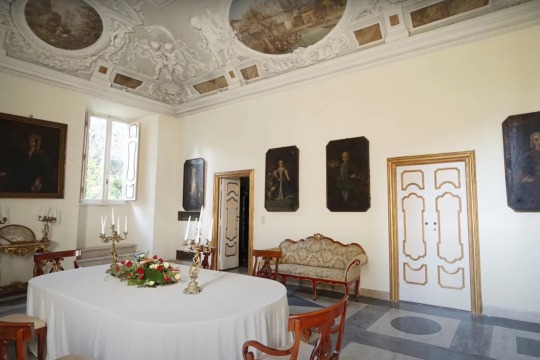




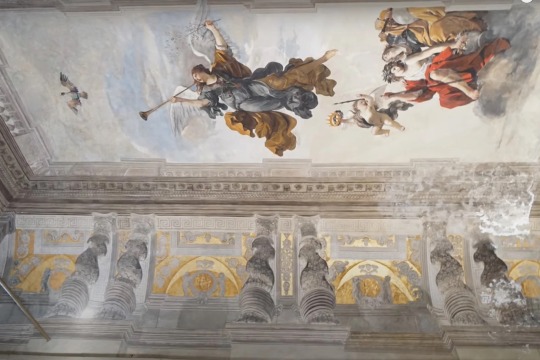
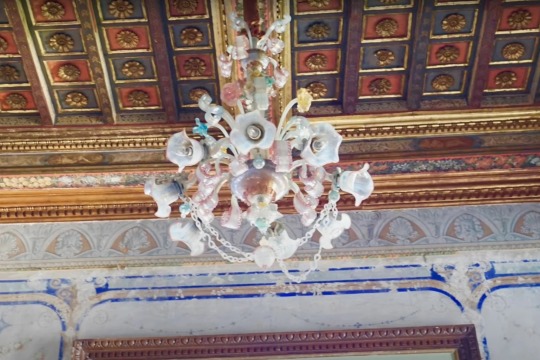
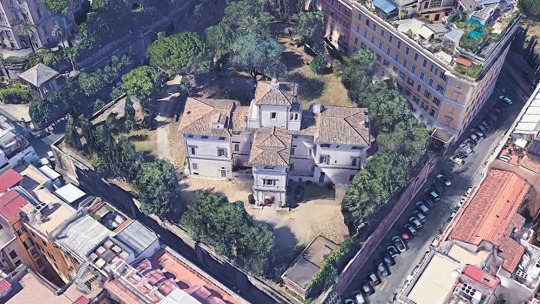
A $547 Million Italian Villa with World's only Caravaggio Ceiling Mural
A stately villa in the heart of Rome, which houses the world's only ceiling mural by the Italian painter Caravaggio, will be auctioned at a starting price of 471 million euros ($547 million) in January, a court in Rome has confirmed.
While most of the infrastructure was demolished in the 19th century, Villa Aurora is the only remaining part of the larger Villa Ludovisi, a 16th-century house which was considered "one of the wonders of the world," according to art historian Claudio Strinati in a column published on the daily Repubblica on Friday.
Barely a stone's throw away from Via Veneto, the iconic street memorialized by "La Dolce Vita" director Federico Fellini, Villa Aurora is flanked by a garden and various garages, and covers a total of 2,800 square meters (just over half an acre), according to public sales documents published by the Justice Ministry.
The six-floor property houses a myriad of artworks including an oil wall painting attributed to Michelangelo Merisi da Caravaggio, better known simply as Caravaggio, whose body of work became synonymous with the artist's visceral depictions of violence.
Spanning the ceiling of a small 2.75 square meter room (approximately 30 square feet), Caravaggio's Villa Aurora mural represents three gods -- Jupiter, Neptune, and Pluto -- as they gather around a translucent globe.
It was commissioned by cardinal Francesco Maria Del Monte in 1597, who would have used the room as an alchemical laboratory, according to the expertise commissioned by a tribunal, published by the ministry.
The painting has an estimated value of more than 310 million euros ($360 million), according to Alessandro Zuccari, a history of modern art professor at Sapienza University of Rome.
Zuccari, who was called by the tribunal to estimate the work of art inside the property, concluded in his evaluation ordered by the tribunal that Caravaggio's painting is "priceless, being the only mural by one of the greatest painters of the modern age."
The villa is also frescoed by the Baroque painter Giovanni Francesco Barbieri, known as Guercino, who worked in the villa between 1621 and 1623. Among Guercino's works are the fresco of the Aurora, the Roman goddess of dawn, which was painted for the nephew of Pope Gregory XV, Alessandro Ludovisi.
Villa Aurora belongs to the Boncompagni Ludovisi family, who are descendants of Pope Gregory XV. However, no detail of the judicial reasons that underlie the auction sale have been disclosed.
But maintenance of the property will not be cheap. One of the conditions for whoever will buy the property will be to spend 11 million euros in restoration expenses.
As a protected art site, the state will have the right of first refusal over the villa.
Auction company Fallco Zucchetti is handling the sale.
#A $547 Million Italian Villa with World's only Caravaggio Ceiling Mural#Villa Aurora#Villa Ludovisi#La Dolce Vita#Caravaggio's Villa Aurora Mural#luxury#luxury estate#luxury real estate#luxury home#luxury homes/estates#luxury living#luxury lifestyle#billionaire#billionaire lifestyle#rich#the good life#$$$
32 notes
·
View notes
